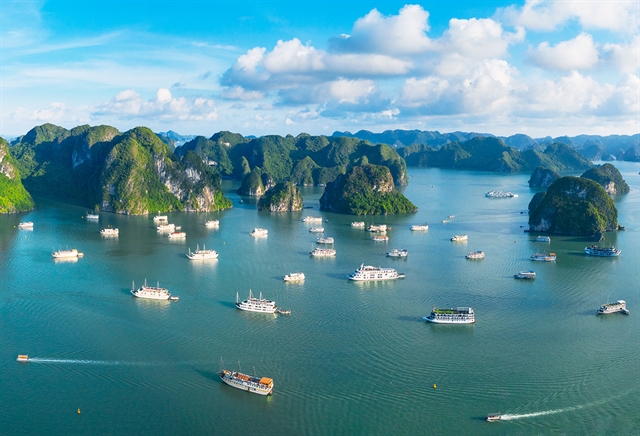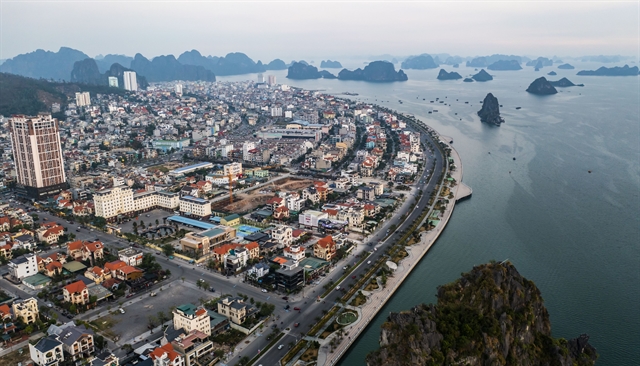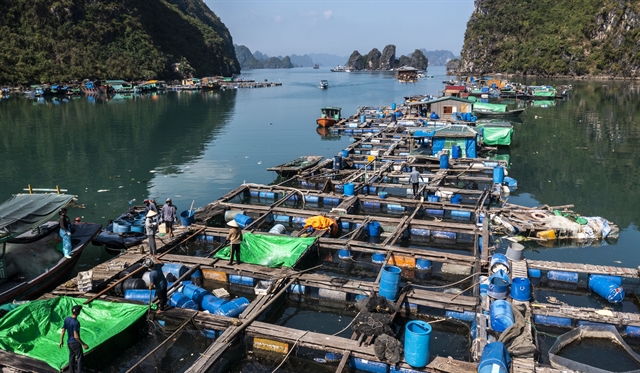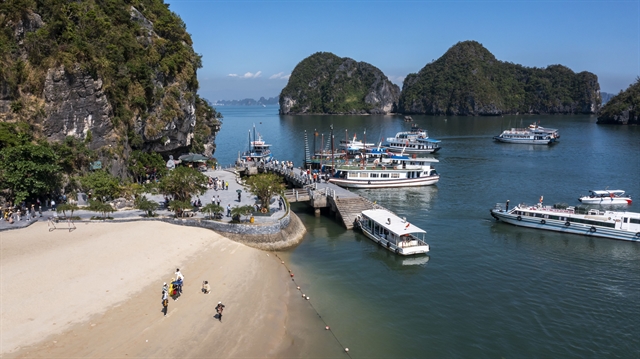Weather:
- Ha Noi 30oC
- Da Nang 30oC
- Ho Chi Minh 29oC

HẠ LONG — Hạ Long Bay, a breathtaking gem of Việt Nam, was recognised as a World Natural Heritage site three decades ago, on December 17, 1994. This 30-year milestone not only marks a moment of pride for Việt Nam but also underscores the immense responsibility that comes with safeguarding such a natural treasure.
Nestled in Quảng Ninh Province, Hạ Long Bay boasts 1,553sq.km of stunning landscapes and 1,969 islands, showcasing both majestic beauty and invaluable geological significance.
A natural wonder
Hạ Long Bay is renowned as one of Việt Nam's outstanding natural wonders. Its towering limestone karst cliffs, sculpted over millions of years, rise dramatically from turquoise waters, creating a picture that seems almost surreal. The bay is home to one of the largest limestone regions in the world, characterised by steep mountains interspersed with serene seas. Notably, the geological formations have left a rich tapestry of caves, including Thiên Cung, Đầu Gỗ and Sửng Sốt, each with its own unique charm and history.
This coastal area of the Gulf of Tonkin serves as a 'natural laboratory' of geology, illustrating the evolution of sea levels through the ages. The bay is also a cradle for prehistoric cultures, such as the Soi Nhụ and Cái Bèo cultures, with archaeological evidence dating back as far as 18,000 years. The Hạ Long culture, emerging around 5,000 years ago, reflects significant exchanges between Southeast Asian and Northeast Asian civilisations, marking a pivotal chapter in the development of ancient Vietnamese culture.

Recognition and expansion
In 1962, Hạ Long Bay was designated a National Monument, a recognition that paved the way for its later accolades. By 2009, it was declared a Special National Monument by the Prime Minister, and in 2011, it earned a place among the New Seven Natural Wonders of the World. The latest chapter in this remarkable story came in 2023, when the World Heritage Committee approved the expansion of the Hạ Long Bay World Heritage boundary to include the Cát Bà Archipelago, now recognised as the Hạ Long Bay - Cát Bà Archipelago Heritage site. This was further celebrated in 2024, when it received certification as an International Geoheritage site by the International Union of Geological Sciences (IUGS).
Over the past three decades, the management and conservation of Hạ Long Bay have posed significant challenges. The immediate aftermath of its UNESCO recognition led to the establishment of the Hạ Long Bay Management Board and the introduction of the Temporary Regulation on Hạ Long Bay Management in 1995. This document was crucial in formalising the legal framework for heritage management, aligning with both national laws and international conventions.
In 2002, the Prime Minister approved a comprehensive plan for the conservation and promotion of Hạ Long Bay's values, extending through 2020. This plan catalysed increased attention from both government and local stakeholders, leading to numerous legal documents aimed at safeguarding the bay's unique heritage.

Sustainable tourism and heritage promotion
From 1994 to September 2024, Hạ Long Bay has welcomed over 56.3 million visitors, generating entrance fees exceeding VNĐ8,472 billion. This impressive figure not only highlights the importance of preserving the bay’s natural state in accordance with UNESCO regulations, but also demonstrates the socio-economic benefits derived from heritage tourism. The revenue generated plays a vital role in reinvestment efforts, enhancing the infrastructure and tourism offerings in the region.
To balance conservation and tourism, Hạ Long City has implemented systematic, long-term strategies focused on sustainable development. Vũ Kiên Cường, Head of Hạ Long Bay Management Board, emphasises the importance of developing new routes and offerings without overwhelming the natural landscape. Initiatives include trial operations of discovery cruises and night cruises that aim to enrich the visitor experience while preserving the area's historical and cultural values.

Cường notes: "Some world heritage sites have had to close due to the risk of destruction. We aim to learn from these experiences, focusing not on the sheer number of tourists but on the sustainability of our resources." This approach involves assessing the bay's carrying capacity to ensure that tourism does not compromise its integrity.
Beyond its tangible cultural values, Hạ Long Bay is home to the unique intangible cultural heritage of its fishing communities. These communities, once thriving on the bay, possess rich folk knowledge and traditions that harmonise with the natural environment. Although many have relocated to the mainland, the customs, beliefs and festivals of these communities continue to be preserved and celebrated, adding depth to the tourism experience.
Cường takes pride in the collective awareness among Quảng Ninh residents and the broader Vietnamese community regarding their responsibility to protect this world heritage site. The Bay Management Board is committed to building a dedicated team equipped with the expertise and enthusiasm needed for effective heritage preservation.
As Hạ Long Bay approaches its next chapter, the focus remains on sustainable practices that respect both nature and culture. The collaboration with experts and researchers continues to play a crucial role in understanding the bay's value and the necessary measures for its conservation.
Hạ Long Bay stands not just as a stunning natural site but as a testament to the delicate balance between tourism and conservation. Its 30-year journey as a World Heritage site reflects the commitment of Việt Nam to preserve its unique heritage for future generations, ensuring that this breathtaking landscape remains a source of pride and wonder for all. VNS


